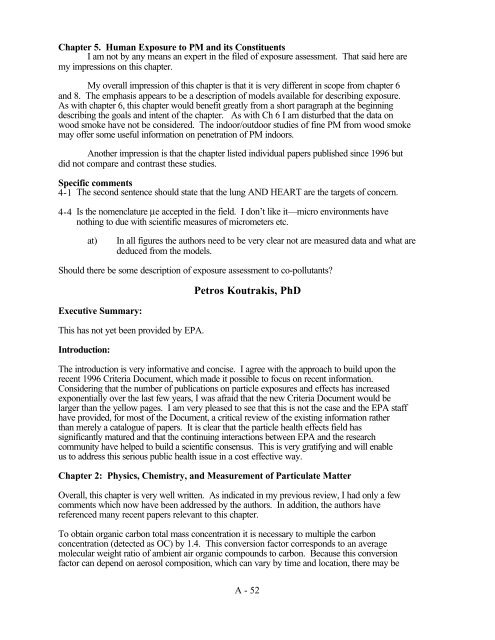Review of the Air Quality Criteria Document for Particulate Matter
Review of the Air Quality Criteria Document for Particulate Matter
Review of the Air Quality Criteria Document for Particulate Matter
- No tags were found...
You also want an ePaper? Increase the reach of your titles
YUMPU automatically turns print PDFs into web optimized ePapers that Google loves.
Chapter 5. Human Exposure to PM and its ConstituentsI am not by any means an expert in <strong>the</strong> filed <strong>of</strong> exposure assessment. That said here aremy impressions on this chapter.My overall impression <strong>of</strong> this chapter is that it is very different in scope from chapter 6and 8. The emphasis appears to be a description <strong>of</strong> models available <strong>for</strong> describing exposure.As with chapter 6, this chapter would benefit greatly from a short paragraph at <strong>the</strong> beginningdescribing <strong>the</strong> goals and intent <strong>of</strong> <strong>the</strong> chapter. As with Ch 6 I am disturbed that <strong>the</strong> data onwood smoke have not be considered. The indoor/outdoor studies <strong>of</strong> fine PM from wood smokemay <strong>of</strong>fer some useful in<strong>for</strong>mation on penetration <strong>of</strong> PM indoors.Ano<strong>the</strong>r impression is that <strong>the</strong> chapter listed individual papers published since 1996 butdid not compare and contrast <strong>the</strong>se studies.Specific comments4-1 The second sentence should state that <strong>the</strong> lung AND HEART are <strong>the</strong> targets <strong>of</strong> concern.4-4 Is <strong>the</strong> nomenclature µe accepted in <strong>the</strong> field. I don’t like it—micro environments havenothing to due with scientific measures <strong>of</strong> micrometers etc.at)In all figures <strong>the</strong> authors need to be very clear not are measured data and what arededuced from <strong>the</strong> models.Should <strong>the</strong>re be some description <strong>of</strong> exposure assessment to co-pollutants?Executive Summary:This has not yet been provided by EPA.Introduction:Petros Koutrakis, PhDThe introduction is very in<strong>for</strong>mative and concise. I agree with <strong>the</strong> approach to build upon <strong>the</strong>recent 1996 <strong>Criteria</strong> <strong>Document</strong>, which made it possible to focus on recent in<strong>for</strong>mation.Considering that <strong>the</strong> number <strong>of</strong> publications on particle exposures and effects has increasedexponentially over <strong>the</strong> last few years, I was afraid that <strong>the</strong> new <strong>Criteria</strong> <strong>Document</strong> would belarger than <strong>the</strong> yellow pages. I am very pleased to see that this is not <strong>the</strong> case and <strong>the</strong> EPA staffhave provided, <strong>for</strong> most <strong>of</strong> <strong>the</strong> <strong>Document</strong>, a critical review <strong>of</strong> <strong>the</strong> existing in<strong>for</strong>mation ra<strong>the</strong>rthan merely a catalogue <strong>of</strong> papers. It is clear that <strong>the</strong> particle health effects field hassignificantly matured and that <strong>the</strong> continuing interactions between EPA and <strong>the</strong> researchcommunity have helped to build a scientific consensus. This is very gratifying and will enableus to address this serious public health issue in a cost effective way.Chapter 2: Physics, Chemistry, and Measurement <strong>of</strong> <strong>Particulate</strong> <strong>Matter</strong>Overall, this chapter is very well written. As indicated in my previous review, I had only a fewcomments which now have been addressed by <strong>the</strong> authors. In addition, <strong>the</strong> authors havereferenced many recent papers relevant to this chapter.To obtain organic carbon total mass concentration it is necessary to multiple <strong>the</strong> carbonconcentration (detected as OC) by 1.4. This conversion factor corresponds to an averagemolecular weight ratio <strong>of</strong> ambient air organic compounds to carbon. Because this conversionfactor can depend on aerosol composition, which can vary by time and location, <strong>the</strong>re may beA - 52
















